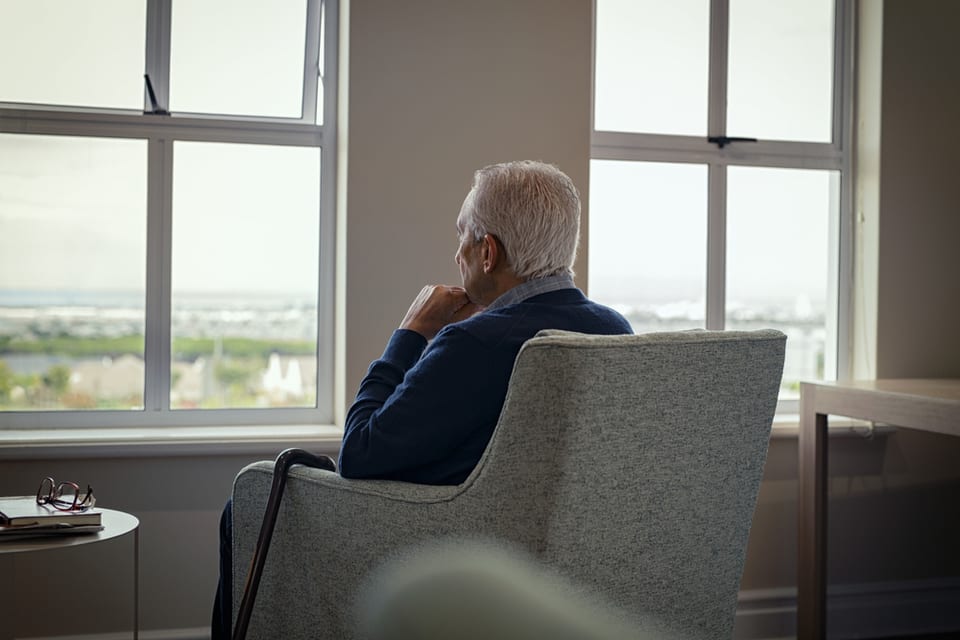
Understanding the Shocking Facts About Senior Isolation

Nearly one-third of all seniors live by themselves, according to the U.S. Census Bureau. That’s close to 14 million seniors aging alone. Senior isolation is both common and dangerous, and while living alone doesn’t inevitably lead to senior loneliness, the two often go hand in hand. Isolation can affect the physical and mental health of seniors, no matter their living situation. Learn how to keep your loved one connected and prevent potentially damaging loneliness.
Let our care assessment guide you
Our free tool provides options, advice, and next steps based on your unique situation.
Increased senior isolation during the coronavirus pandemic: Loneliness levels still aren’t back to normal
Early in the coronavirus pandemic, the Centers for Disease Control and Prevention urged older adults — the group at highest risk for severe illness with COVID-19 — to stay home with few, if any, visitors. Many of those restrictions were lifted with the approval of coronavirus vaccines and booster shots in 2021 and 2022, and while the country has reached a “new normal” in many ways, increased social isolation and loneliness in older adults persist.
“My mother has lived alone several hours away from family for years,” said Imani, 53, a nurse practitioner in Atlanta. “She had a booming social life before the pandemic hit — garden club, yoga classes, and a church group. She was always busy. But partway through 2020, the lack of activity started to show. Her decline was shocking, even over FaceTime calls.”
Statistics on senior isolation are changing course
It’s undeniable that social restrictions helped physically protect people throughout the pandemic, but those same precautions limited seniors’ interactions with friends and family, leading to a stark increase in reported elderly isolation. In fact, 56% of older adults said they felt isolated in June 2020, according to a University of Michigan poll on healthy aging.[01] That’s more than double the number of seniors who reported feeling isolated in 2018’s healthy aging poll.
In the most recent University of Michigan Poll, published in early 2023, those numbers have dropped again — but they still haven’t reached pre-pandemic levels of loneliness. Now, 34% of seniors report feeling isolated, while an additional 37% feel a “significant” lack of companionship.[02]
It’s important to keep these trends in mind and focus on decreasing loneliness to pre-pandemic levels, since senior isolation can lead to depression, weight loss, cognitive decline, and other medical complications, research suggests.
“Mom was losing weight — you could see it in her face — and she would often tell the same stories as she had the last week,” Imani said. “At some point, she admitted she was only eating once or twice a day, without lunch dates with friends.”

Let our care assessment guide you
Our free tool provides options, advice, and next steps based on your unique situation.
The health dangers of social isolation and loneliness in elderly adults
Loneliness can be as deadly as smoking or obesity, according to a study published in the journal Perspectives on Psychological Science. Senior isolation may complicate existing conditions, encourage an unhealthy lifestyle, and affect cognition.[03]
- Unhealthy habits increase when seniors are isolated. Social isolation often leads to bad health habits, according to the American Psychological Association.[04] Lonely seniors are more likely to smoke, drink in excess, and neglect the need for physical activity. Humans are hard-wired for connection, and if we’re not experiencing it, there can be serious ramifications. According to Maslow’s Hierarchy of Needs, “love and belonging” directly follow physiological needs such as food, water, sleep, and oxygen. Conversely, social support can encourage seniors to eat well, exercise, and live healthy lifestyles.
- Balanced diets are more difficult for lonely seniors. Because of decreased appetites, medication side effects, and physical changes, seniors may be less likely to eat healthy, balanced meals.
- Loneliness increases the risk of Alzheimer’s disease. Loneliness is a risk factor for cognitive decline, according to a study conducted by the Rush Institute for Healthy Aging.[05] In the study, the risk of Alzheimer’s nearly doubled in lonely seniors, and mental decline was faster. This could be because isolated older people have less stimulation, or because their symptoms are less likely to be reported before the disease has progressed, the study suggested.
- Stress follows loneliness. Researchers at the University of Chicago note blood pressure and stress levels are “significantly higher” in lonely people, especially seniors.[03] “I felt like I couldn’t get out of bed some mornings,” said Anne, 78, of Elizabethtown, Kentucky. “My stress was through the roof, and when I went to the doctor in 2021 my blood pressure was way up.” Isolation leads to higher instances of elder abuse. Isolated seniors are more likely to fall prey to scammers and financial mistreatment. Neglect, one of the lesser-known types of elder abuse, is more likely to go unnoticed. Seniors themselves are less likely to report physical abuse without a trusted family member, and they may protect abusers if they don’t have other caregiving resources.
- Lonely seniors assume the worst. Socially isolated seniors are 60% more likely to predict their quality of life decreasing over the next 10 years.[06] They’re also more concerned about needing help from community programs as they get older, and they’re more likely to express concerns about aging in place. “Mom always said she’d stay in that house until she died. She was stubborn. But she started getting concerned. ‘What if I can’t stay here anymore? What if I have to go to a home?’ She kept bringing these things up,” Imani said.
The “double pandemic”: Coronavirus and senior isolation health risks
Senior isolation was a core concern during the coronavirus pandemic, according to a University of Washington study of social services and health care organizations across the state. According to the study, organization leaders expected the impact of social isolation in seniors to persist well after restrictions were lifted, leading to “exacerbated problems of dementia, depression, suicide risk, and disrupted care.”[07]
They were right.
“Even after I started being able to see family again — after we were all vaccinated — I felt this pressing sense of depression,” Anne said. “I felt like I’d missed a year of my life, isolated from grandbabies and my son.”
Family caregivers agree social distancing and the stress of the pandemic affected their aging loved ones. Sixty-two percent of adult children caring for their parents or elderly relatives say their loved one has suffered physically or mentally from senior isolation during the pandemic, according to a December 2020 survey from A Place for Mom.
Some groups particularly affected by pandemic isolation include:
- Seniors in need of preventive health care who may postpone regular appointments, tests, and elective surgeries
- Older adults with impaired mobility who may lose the benefits of regular physical therapy or suffer bedsores from decreased movement
- Seniors with lower incomes who may rely on public transportation or may be essential workers
- Older adults with depression, anxiety, or other mental illnesses that may go untreated without access to a therapist
- Unpaid spousal caregivers who have limited respite from their duties and are more likely to experience caregiver stress and health problems
- Seniors with chronic conditions who may have less support for disease management and postpone medical visits to avoid exposure to COVID-19
- People living with dementia who require cognitive and sensory stimulation and benefit from seeing relatives and familiar faces
Read related article:Depression in Elderly Adults: Signs, Symptoms, and Treatments
7 reasons more seniors are aging alone
As far back as the 1950s, psychiatrist Frieda Fromm-Reichmann raised awareness about the dangers of loneliness, which she defined as the difference between someone’s “preferred and actual social relations.”
“Even before the pandemic, I was living alone, and I did feel lonely sometimes because I was very social when I was younger,” Anne said. “Since my husband passed in 2014, it just hasn’t been the same.”
Here are seven contributing factors to senior isolation.
- Family dynamics have changed. Divorce rates have nearly doubled over the past 40 years, and the number of adults who never married is at an all-time high, according to the most recent U.S. Census.[08]National birth rates also plummeted after the baby boomer generation, meaning more seniors are childless. These factors lead to a decrease in family social ties, which, in turn, often prevents intergenerational caregiving.
- Women are more likely to live alone than men. Higher percentages of older women never married or are either widowed or divorced. The median income of women older than 65 is $18,380 — that’s roughly half of men’s $32,000 average, according to a study conducted by the Administration for Community Living.[09] This financial discrepancy makes it more difficult for single women to afford home health care or assisted living later in life. Interestingly, more men report being lonely in old age, while women are more content to age alone.
- Neighborhoods evolve. Many seniors choose to stay home as long as possible, often citing their community as the main reason to age in place. However, community dynamics change over time: Gentrification, new job opportunities, and an increase in urban living can bring in younger neighbors, which can isolate seniors. 55+ communities can be a good option for seniors who want to maintain a neighborly environment as they age.
- LGBTQ+ seniors are more likely to be socially isolated. LGBTQ+ seniors are twice as likely to live alone, according to SAGE, an organization that advocates for LGBTQ+ elders.[10] This is because they’re less likely to have children and are more commonly single or estranged from their biological families.
- Transportation challenges lead to social isolation. Forty-one percent of seniors believe that transportation in their communities is inaccessible or inadequate. Because many people lose their ability to drive as they age, they’re likely to be isolated without available transit.
- Married couples can be lonely, too. Seniors don’t have to live alone to be lonely. Older adults who are married are just as likely to report feeling isolated as those who aren’t married. This is partially because couples who focused on children for years aren’t used to living without them. Spouses who act as caregivers for their partners are at risk of emotional isolation, as they often don’t have time for activities or social outings.
- Seniors may feel they’re being left behind. New technologies and lifestyles can be overwhelming for seniors. The first generation to experience color TV and the personal computer is now inundated with new, seemingly inaccessible tech that often lacks proper instruction.

Talk with a Senior Living Advisor
Our advisors help 300,000 families each year find the right senior care for their loved ones.
Ways to combat senior isolation and elderly loneliness
From spending time with friends to visiting community centers or houses of worship, there are many ways for older adults to maintain connections. Even routine interactions, like checking out at the grocery store or chatting with the mail carrier, can offer much-needed socialization. Now that most older adults can participate in safe activities with family and friends again, there are several ways to help your loved one feel more active and engaged.
- Learn how to combat senior loneliness and isolation. Review these nine key tips from a top Cleveland Clinic physician to understand the importance of socialization, plus how you can help your loved one remain engaged.
- Explore intergenerational programs to build relationships. Intergenerational programs can offer aging loved ones a sense of purpose, as well as an essential social outlet.
- Find social engagement in senior living. Loneliness can be reduced when you have friends and neighbors nearby for activities, meals, and conversation. This regular engagement can improve health and wellness in older adults.
- If your loved one is still concerned about the potential of contracting COVID, consider these activities for seniors social distancing. Families and friends can stay connected with these unique takes on classic activities, no matter their level of comfort regarding pandemic regulations. From virtual movie nights to socially distanced crafting, there’s something for everyone.
How senior living can help your loved one beat loneliness
“In October of 2021, we realized something had to change,” Imani said. “Mom didn’t want to go to senior living, but she also really didn’t know what it was all about.”
Imani’s mother ended up choosing an independent living community just a few blocks from her old home.
“I think she still drives past that house to check up on it,” Imani laughed. “She got to keep her friends and also made new ones. She’s started eating again, loves that there’s a beauty shop there, and has joined another Bible study in addition to the one at her church. It’s been a lifesaver for all of us.”
There are many ways a senior living environment defeats loneliness in seniors, in many ways that your loved one may not even anticipate. Every senior living environment has a unique community culture all its own, with clubs, activities, and events centered around resident’s interests. Matching a community to your loved one in this way can make a dramatic difference in your loved one’s life.
For example, if your loved one is interested in art, try to find a community offering professional art classes on-site. Or if your loved one has a green thumb, choose a community with an exceptional gardening program. Perhaps your loved one is a devout Catholic, in which case finding a Catholic assisted living community would be a great fit.
If you think senior living could help your loved one remain social and avoid senior isolation, reach out to one of A Place for Mom’s Senior Living Advisors. They can discuss your family’s unique preferences and care needs to help you find the best fit, all at no cost to you.
Increased senior isolation during the coronavirus pandemic: Loneliness levels still aren’t back to normal
Piette, J. (2020, September 14). Loneliness among older adults before and during the COVID-19 pandemic. University of Michigan.
Malani, P. (2023, March 13). Trends in loneliness among older adults from 2018-2023. University of Michigan.
Cacioppo, S., Grippo, A., London, S., Goossens, L., & Cacioppo, J. (2015). Loneliness: Clinical import and interventions. Perspectives on Psychological Science.
American Psychological Association. (2020, October). Stress in America 2020: A national mental health crisis.
Bennett, D.A., Schneider, J.A., Buchman, A.S., Barnes, L.L., Boyle, P.A., & Wilson, R.S. (2012). Overview and findings from the Rush Memory and Aging Project. Current Alzheimer Research.
Real World Health Care Editorial Staff. (2021, March 31). COVID-driven isolation can be dangerous for older adults. National Council on Aging.
Eckhart, K. (2020, October 21). Pandemic further isolating older adults, as senior services struggle to adapt. UW News.
United States Census Bureau. (2021, November 30). 2020 ACS 1-year experimental data tables.
Administration for Community Living. (2021, May). 2021 profile on older Americans.
SAGE. (2020, August 31). Startling mental health statistics among LGBTQ+ are a wake-up call.
Senior living options in all states
The information contained on this page is for informational purposes only and is not intended to constitute medical, legal or financial advice or create a professional relationship between A Place for Mom and the reader. Always seek the advice of your health care provider, attorney or financial advisor with respect to any particular matter, and do not act or refrain from acting on the basis of anything you have read on this site. Links to third-party websites are only for the convenience of the reader; A Place for Mom does not endorse the contents of the third-party sites.
Make the best senior care decision
Make the best senior care decision